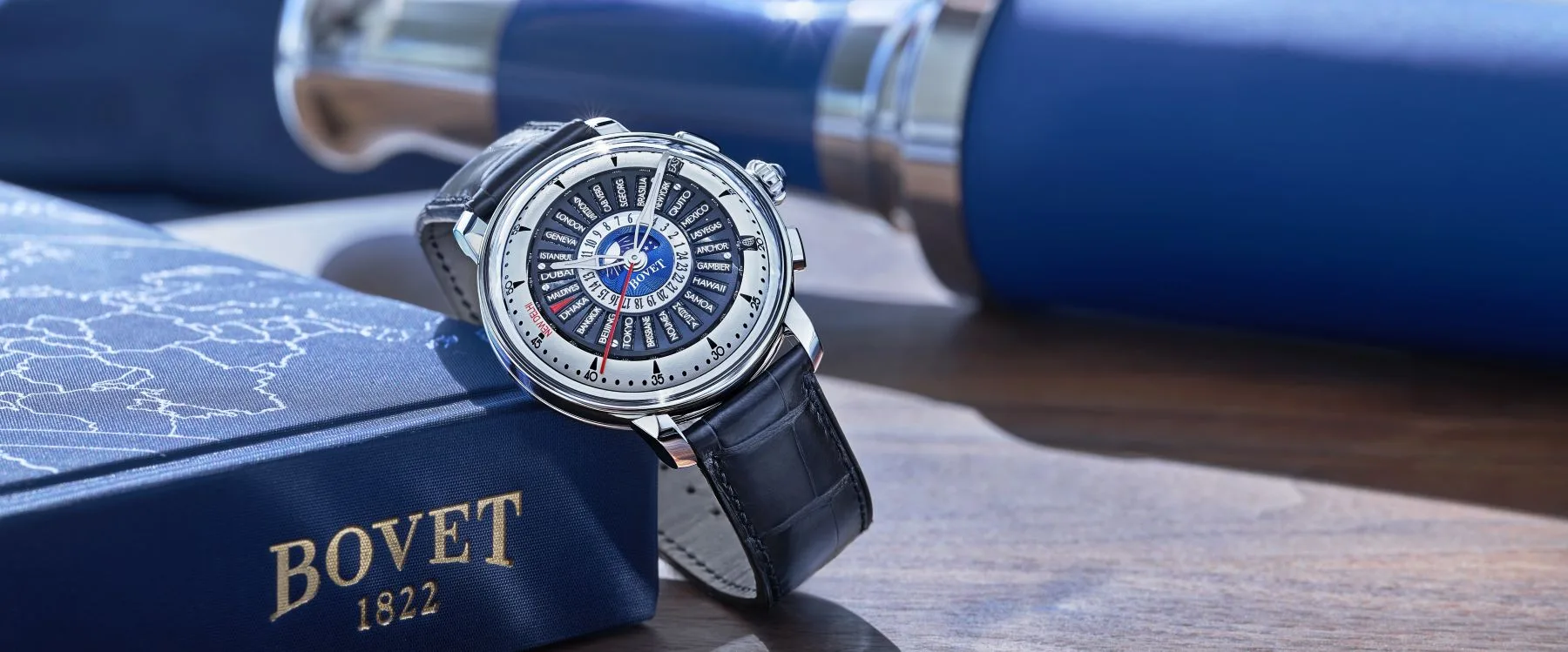In a sense, it was a quieter year for Patek Philippe, but that does not mean the watches presented were not superlative. Along with a Rare Handcrafts Exhibition at their Geneva boutique and the integration of the crafts into the watches released at Watches & Wonders, this was a year aimed more at the collector and cognoscenti, with new versions of well-loved classic models, a celebration of their ladies’ line, and a re-generation of a much-loved mid-20th century design.
As part of the Rare Handcrafts theme, there was an exhibition at the main Geneva boutique which demonstrated the extent of artistic endeavours that the company’s artisans can realise. A number of different metiers d’art were on display, from guilloché to enamelling, gem-setting and engraving.
One of the stars of the Rare Handcrafts Exhibition, a Patek Philippe Calatrava metiers d’art with a wood marquetry image of Morning on the Beach.

Out of all of the watches shown, my favourite was the Calatrava ref. 5089G Morning on the Beach, an innovative juxtaposition of a centuries-old art form and a modern pictorial setting, which also represents a different aesthetic by Patek Philippe. Marquetry is the painstaking use of coloured wood varieties, taking into account the vein and how they can cut, assemble, glue and place each tiny piece of veneer for use in the composition. In this instance, the grain of the wood, used horizontally, depicted the waves in the water; the grain, used vertically, reflects the upright surfer as he walks across the beach.
Traditionally used in furniture, its use in watchmaking is fairly recent and pioneered by Patek Philippe. In this instance, 100 veneer parts and 75 inlays comprising 23 species of coloured wood, show a surfer on his way to the waves. The case is white gold with a hinged back cover that opens to the brand’s ultra-thin automatic calibre 240. If I could have only had one watch to take home with me this year, then this would have been it. As a former resident of the city, it reminded me of mornings in Los Angeles. A limited edition of 10 pieces and POA.


Left, Patek Philippe advert for the new Ellipse circa 1971, showing the intended customer profile. Right, the new ref. 5738R Ellipse.
The new rose gold Ellipse has all the hallmarks of the late 1960s icon, with all the benefits of a new movement and re-worked bracelet. The Ellipse was introduced in 1968, with the references 3546 and 3548, as the company needed a new watch design that was both immediately recognisable as a Patek and unisex in its appeal. Something that would be distinguishable from any other watch. The Ellipse became the symbol of 1970s jet set international chic. It featured in most of the company’s advertising from the late 1960s through the early 1980s, becoming a success in the process. In total, over the years, the number of Ellipse references – 65 in total – even eclipses the number for the Calatrava.
The contemporary shape of the watch owes more to the Jumbo Ellipse ref. 3605 introduced in 1971 with an automatic calibre 28-2555C. The new ref. 5738R has the same oversized rectangular round case shape with an intricate bracelet in the same metal. Powered by the modern automatic calibre 240, it is every part the modernised successor to the quintessential 1970s classic.
Subtle improvements have been made to the bracelet, where 300 of the 383 links are polished and assembled by hand. Reminiscent of the traditional Frères examples of the past, it adds flexibility and ergonomics to how the watch sits on the wrist. With all gold case and bracelet watches making a marked return, the modern Ellipse is as avant-garde and modern today as it has always been.

The 25th Anniversary Patek Philippe Twenty~4 with the purple concentric wave pattern dial and two-tier case lined by two rows of diamonds.
Of equal standing is the Patek Philippe Twenty~4 collection, introduced in 1999, which is celebrating its 25th anniversary. The new version of the quartz cuff-style model features a highly refined dial embossed with a concentric wave pattern, coated with successive layers of a translucent purple lacquer, which, once polished, creates a beautiful depth effect. The original shape of the rectangular two-tier case is highlighted by two rows of 17 brilliant-cut diamonds set on either side of the dial.



New Patek Philippe Grand Complications. From left to right, Perpetual Calendar ref. 5236P, Alarm Travel Time ref. 5520R and Rare Handcrafts Retrograde Perpetual Calendar ref. 5160R.
For the purist collectors, there were three stunning versions of Patek Philippe grand complications; that sweet spot that the Geneva Maison knows so well. First, a peerless new Perpetual Calendar, ref. 5236P. Initially introduced four years ago with a blue dial/white gold case combination, the reference is now clad in platinum with a rose-gold gilt salmon pink dial. Second, the quintessential travel watch, the Alarm Travel Time ref. 5520R, which now comes in a two-tone version with a rose gold case featuring four white gold pusher tubes and a sunburst grey dial. Third, and part of the Rare Handcrafts work, a Retrograde Perpetual Calendar ref. 5160R with a silvery opaline dial, in an Officer’s-style case with a hinged cover and hand-engraved decoration throughout, inspired by a pocket watch from the Patek Philippe Museum.


The two new complicated watches released this year, the ref. 5330G World Time (left) and the ref. 5396 Annual Calendar (right).
Patek Philippe continued their tradition with the World Time complication (patented ref. 5330G). Originally released as a limited edition for the Patek Philippe grand exhibition Watch Art held in Tokyo in June 2023, the new calibre is now part of the regular collection and ingeniously has a date display synchronized with local time – the one indicated by the centre hands on the dial. Also in the complications category, Patek Philippe released a sublime new version of the ref. 5396 Annual Calendar in white gold, featuring a sunburst blue dial with black-gradient rim, discreetly enhanced by the brilliance of twelve baguette diamond hour-markers.


The two new Aquanaut watches, the ref. 5164G Travel Time (left) and the ref. 5268G Rare Handcrafts gem-set Aquanaut Luce (right).
Finally, the other collections with new references were the Aquanaut and Nautilus. In the former, there were three new iterations, a white gold opaline blue-dialled ref. 5164 Travel Time, a Travel Time ref. 5269 in a rose gold case, featuring a similar hue on its dial, but with a quartz movement, and an Haute Joaillerie white gold Luce model, ref. 5268G, that was part of the Rare Handcrafts Exhibition. The Nautilus ref. 5980G, a self-winding flyback chronograph, comes in a white gold version, also with an opaline blue dial.
Patek Philippe’s Rare Handcrafts exhibition is coming to London from 7th – 16th June at the Patek Philippe Bond Street salon.
Words: Dr Andrew Hildreth
Opening image: detail of the dial for the Calatrava ref. 5089G Morning on the Beach.

















Show Comments +